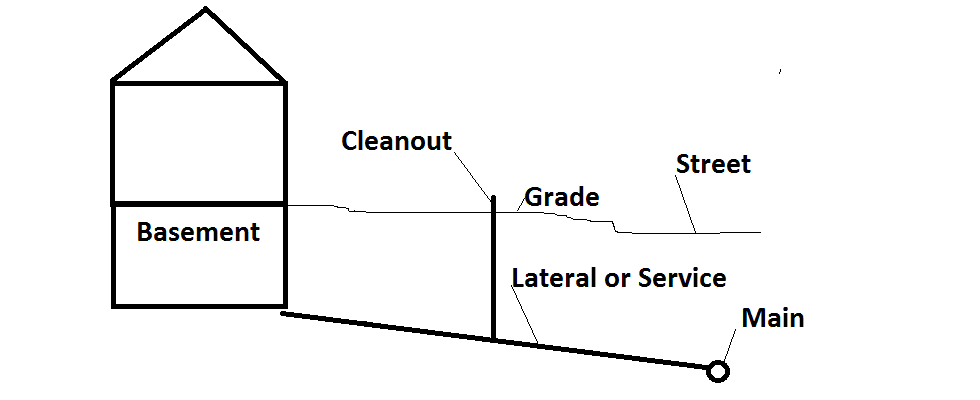House Sewer Protection
0 Comments | Posted by armchairbuilder in Build Your Own Home, Owner-Builder, Quality Check
One of the critical items you need to protect when building a new home is your house sewer. The pipe that comes from the street to your home is a vital component to the operation of your home’s plumbing system. Without proper protection, damage can occur and backup of raw sewage into your home is possible. So, let’s talk about a few builder secrets to keep your house sewer up and running.
House Sewer Components
In order to properly discuss your house sewer we need to identify the common terms for each of the components. For this discussion, let’s assume your community has sewer service. If not, the main will be the location of your septic system, the lateral will go from your home to the septic system and the cleanout will come up vertically from the lateral.
Main: This is the pipe typically located under the street in front of your home that collects all of the sewage in your neighborhood. The depth of this pipe dictates how deep the pipe to your house sewer service pipe will be.
Lateral: This is the pipe that connects to the main from your home. The service line or sewer lateral (we will call it the lateral for this discussion) is the pipe that collects the dirty drain water (and toilets) from you home and flows by gravity out to the sewer main pipe at the street.
Cleanout: Most house sewer laterals have a cleanout in the yard. This is just a vertical pipe that attaches to the sewer lateral and has a cap on the top. If there is ever a problem, the cap can be removed to access the lateral for cleaning or for running a camera down to inspect.
Engineered Plot Plan
It’s a good idea to have your engineer put the sewer lateral (or service line) on your plot plan drawing. This is good to have just in case the cleanout gets buried during construction. If the lateral is shown on the plot plan, it will be easy to locate. Go ahead and have your engineer place the water service to your house on the drawing as well.
If the lot you purchase does not have a pipe or marker stake showing the location of the sewer lateral, you can check with the developer of the property. Typically, the overall development drawings will show where the connections are for each lot. If you can’t get ahold of the developer, the local building department or public works department should have it as well.
Rebar at Cleanout
This is an old builder trick…place a piece of rebar next to your house sewer cleanout when it is installed. If the cleanout gets buried, you will easily be able to find it with a metal detector. You don’t want to make matters worse by digging up the front yard with a backhoe and possibly damaging the sewer line to the house. Another good preventative measure is to mark the curb in front of your future home with the sewer and water service line locations. We talked previously about this rebar technique for finding your property lines.
2×10 in Front of Cleanout
Your new house sewer lateral is typically installed early in the schedule somewhere just after the foundation is installed. So, there are all kinds of deliveries and heavy equipment that will be on your property from the time of installation until the time you close on the house. What happens if a truck hits the cleanout? In the best case scenario, if the cleanout is hit, it will break apart where it enters the ground. The worst case scenario is the cleanout gets pushed down into the ground and it crushes the sewer lateral. This will require hundreds of dollars to dig up and repair and even more if you have an extra deep lateral (sometimes over ten feet deep). And if you don’t notice the damage and you go ahead and move in…you might end up dealing with a sewer backup into your home months down the road.
The best way to protect your house sewer cleanout is by placing something big and solid in front of it while your new home is being built. We typically have placed a 2×10 vertically in the ground in front of it and paint it orange so truck drivers will see it.
Scopes of Work and Specifications
Make sure you include a note in your scopes of work and specifications that each subcontractor and supplier is responsible for any damage on site that is caused by them.
Daily Quality Check
It’s always a good idea to do a complete quality check at the end of each day during construction of a new home to check for this type of damage. After deliveries, check curbs, cleanouts, sidewalks…etc. for any damage that might have occurred. After a day or two goes by, you will be less likely to know for sure who the culprit was.
Cut to Grade
You will want to wait until the landscapers have finished landscaping the yard to cut the sewer cleanout down to grade. Again, it’s about making sure that everyone knows where it is so tractors and bobcats can avoid it. Once the grass seed or sod has gone down, you can cut it down to grade and paint it green.
The Builder’s Daily Construction Guide
This tip is one of the many builder secrets that are in The Builder’s Daily Construction Guide. This guide gives the person that wants to build their own home a daily checklist of things to do. Based on years of building homes, this guide was created by a builder to make sure nothing was forgotten. Get you copy of The Builder’s Daily Construction Guide to make sure you build a quality home at the best price.



